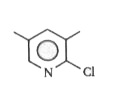BCl3+H2+C1700−1800∘C−−−−−−−−→Product(s)
The product(s) of above reaction is/are
CCl4+B2H6
B4C+HCl
B+Cl2+CH4
B2H6+CHCl3
The correct Answer is:B
To solve the reaction of boron trichloride (BCl₃) with hydrogen (H₂) in the presence of carbon at high temperatures (1700-1800 °C), we can follow these steps:
1. Identify the Reactants: The reactants in the reaction are boron trichloride (BCl₃), hydrogen (H₂), and carbon (C).
2. Understand the Reaction Conditions: The reaction occurs at a high temperature (1700-1800 °C). High temperatures can lead to the formation of complex compounds.
3. Predict the Products: The reaction between BCl₃ and H₂ in the presence of carbon typically leads to the formation of boron carbide (B₄C) and hydrochloric acid (HCl).
4. Write the Balanced Chemical Equation:
- The unbalanced equation can be written as:
BCl3+H2+C→B4C+HCl
- To balance the equation, we need to ensure that the number of each type of atom on the reactant side equals the number on the product side.
- Balancing the equation:
- There are 4 boron atoms in B₄C, so we need 4 BCl₃.
- Each BCl₃ has 3 Cl, so 4 BCl₃ gives 12 Cl, which means we need 12 HCl.
- To balance hydrogen, we need 6 H₂ (since each H₂ provides 2 H).
- Carbon remains as 1 in the product.
- The balanced equation is:
4BCl3+6H2+C→B4C+12HCl
5. Identify the Final Products: From the balanced equation, the products formed are:
- Boron carbide (B₄C)
- Hydrochloric acid (HCl)
Conclusion:
The products of the reaction between BCl₃, H₂, and C at high temperatures (1700-1800 °C) are boron carbide (B₄C) and hydrochloric acid (HCl).
- The unbalanced equation can be written as:
BCl3+H2+C→B4C+HCl
- To balance the equation, we need to ensure that the number of each type of atom on the reactant side equals the number on the product side.
- Balancing the equation:
- There are 4 boron atoms in B₄C, so we need 4 BCl₃.
- Each BCl₃ has 3 Cl, so 4 BCl₃ gives 12 Cl, which means we need 12 HCl.
- To balance hydrogen, we need 6 H₂ (since each H₂ provides 2 H).
- Carbon remains as 1 in the product.
- The balanced equation is:
4BCl3+6H2+C→B4C+12HCl
- Boron carbide (B₄C)
- Hydrochloric acid (HCl)
The products of the reaction between BCl₃, H₂, and C at high temperatures (1700-1800 °C) are boron carbide (B₄C) and hydrochloric acid (HCl).
Similar Questions
Knowledge Check

Product (A) of above reaction is:ACH3OCH∣CO2H−CH2−CH2−CHOBCH3O−CH2−CH2H∣CH−CH2−CO2HCCH3O−C∣CO2HH−CH2−CH2−CO2HDCH3O−CH∣CO2H−CH2−CH2−CH2−CHO
Product (B) of above reaction is :A B
B C
C D
D

Product (A) of the above reaction isAPh−OH∣CH−CH2−O∣∣C−OHBPh−OH∣CH−CH2−O∣∣C−OEtCPh−CH−CH−CH2−OHDPh−CH=CH−CH3


 product of above reaction is :
product of above reaction is :



